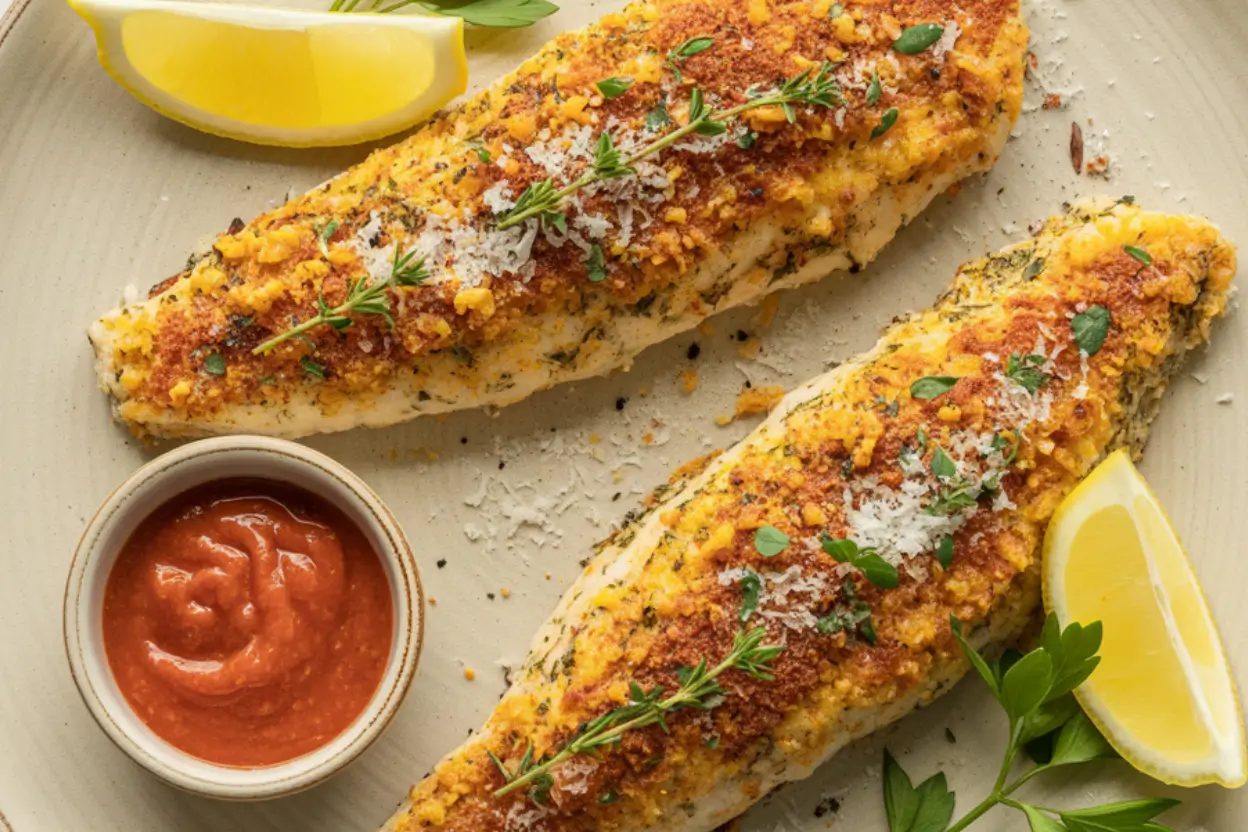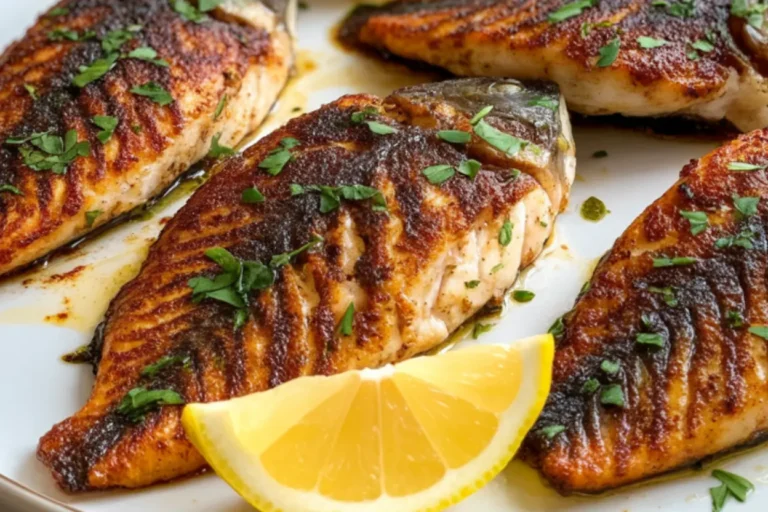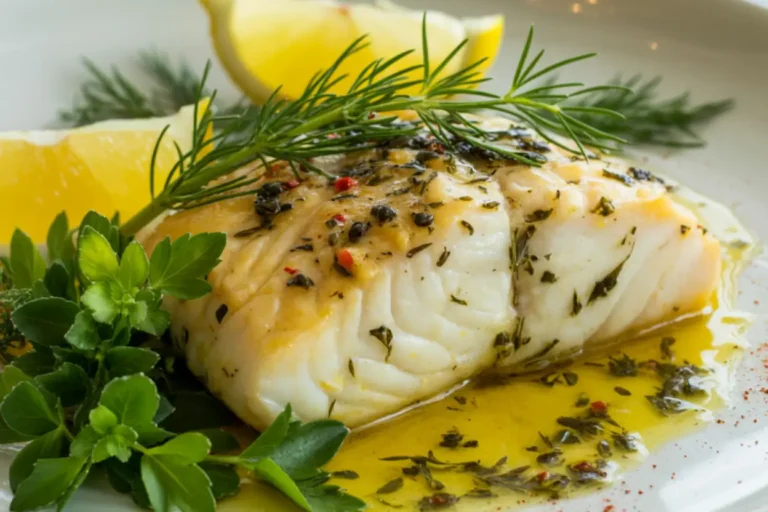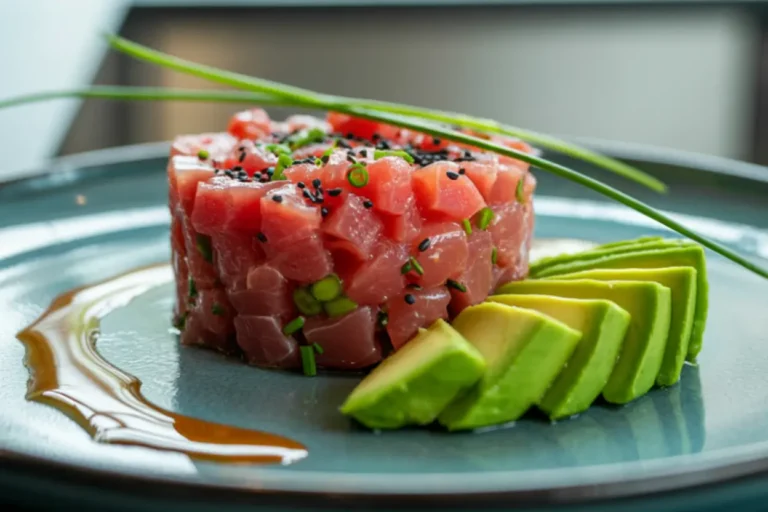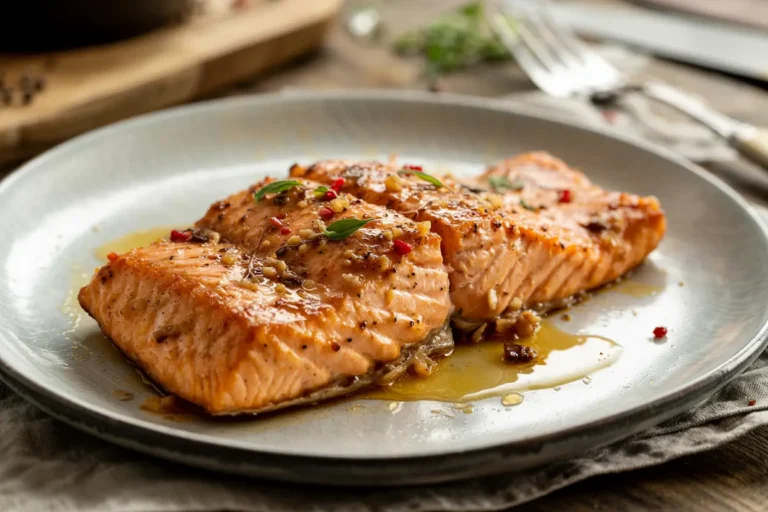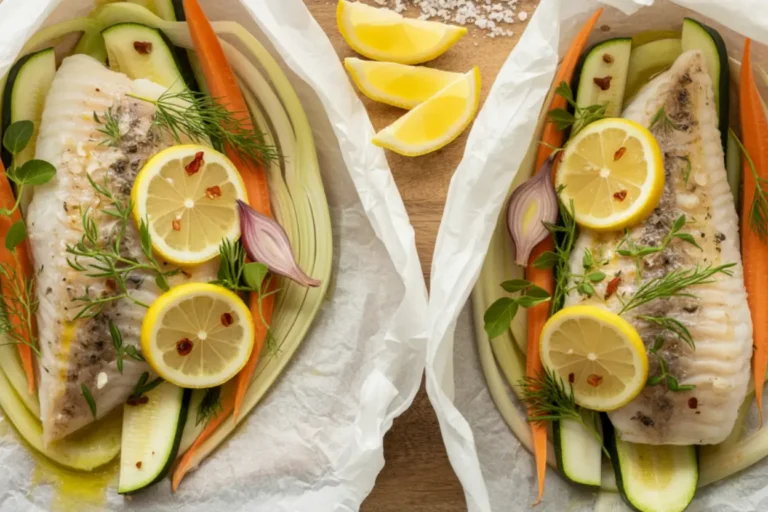Baked catfish: How to Get Flavor Without Frying
Table of Contents
As someone who grew up in the South, I’ve eaten my fair share of fried catfish—that crispy, cornmeal-crusted delight that’s practically a regional institution. But after years of perfecting healthier cooking methods, I’m here to tell you that baked catfish can be every bit as flavorful and satisfying as its fried counterpart, without the extra calories and mess. This recipe has converted even the most dedicated fried catfish enthusiasts in my family, and I’m confident it will win you over, too.
Thank you for reading this post, don't forget to subscribe!How to Make Baked Catfish:
Quick Overview
This baked catfish recipe delivers that satisfying crunch and savory flavor you crave from traditional fried catfish, but with a significantly lighter profile. The secret lies in a flavorful herb and spice coating paired with a smart baking technique that creates a wonderfully crisp exterior while keeping the fish moist and tender inside.
What makes this dish particularly appealing is its simplicity—just mix your seasonings, coat the fish, and let your oven do the work. No oil splatter to clean up, no standing over a hot skillet, and no greasy aftermath. Yet the results are remarkably delicious, with a golden crust and perfectly flaky fish.
From start to finish, you’ll spend about 30 minutes making this recipe, with just 10 minutes of active prep time. The oven handles the rest, making this an ideal weeknight dinner when you want something that tastes special without requiring hours in the kitchen.
The Ingredients I Use to Bring My Baked Catfish to Life
For the fish (serves 4):
- 4 catfish fillets (about 6 ounces each), patted dry
- 2 tablespoons olive oil or melted butter
- 1 tablespoon fresh lemon juice
For the coating:
- 2/3 cup panko breadcrumbs
- 1/3 cup cornmeal (yellow or white)
- 2 tablespoons grated Parmesan cheese
- 1 teaspoon paprika (regular or smoked)
- 1 teaspoon garlic powder
- 1 teaspoon onion powder
- 1 teaspoon dried thyme
- 1 teaspoon dried oregano
- 1/2 teaspoon cayenne pepper (adjust to taste based on your heat preference)
- 1 teaspoon salt
- 1/2 teaspoon freshly ground black pepper
- Zest of 1 lemon
For serving:
- Lemon wedges
- Fresh parsley, chopped
- Hot sauce (optional)
Step-by-Step Instructions
Step 1: Prepare for Baking
- Preheat your oven to 425°F (220°C). This high temperature is crucial for achieving a crisp exterior on your baked catfish.
- Line a baking sheet with parchment paper or aluminum foil, then place a wire rack on top. Lightly spray the rack with cooking spray or brush with a thin layer of oil. This setup allows air to circulate around the entire fillet, resulting in a crispier finish on all sides.
- Pat the catfish fillets dry with paper towels. This step is essential—removing excess moisture helps the coating adhere better and promotes browning.
Step 2: Create the Flavorful Coating
- In a shallow dish or plate, combine the panko breadcrumbs, cornmeal, Parmesan cheese, paprika, garlic powder, onion powder, dried thyme, dried oregano, cayenne pepper, salt, black pepper, and lemon zest.
- Mix thoroughly with a fork to ensure all seasonings are evenly distributed throughout the breading mixture.
Step 3: Prepare and Coat the Fish
- In a small bowl, combine the olive oil (or melted butter) and lemon juice.
- Brush each catfish fillet on both sides with the oil-lemon mixture. This enhances the flavor and also helps the coating adhere better to the fish.
- Place each moistened fillet into the breading mixture, pressing gently to ensure the coating adheres to all surfaces. Flip and repeat on the other side, then gently press the sides of the fillet into any remaining coating.
- Carefully transfer the coated fillets to the prepared wire rack, leaving at least an inch of space between each piece to allow for proper air circulation.
Step 4: Bake to Perfection
- Set the baking sheet on the center rack of your preheated oven.
- Bake for 15–20 minutes, or until the coating turns golden brown and crispy and the fish flakes easily with a fork. Cooking time may vary based on the thickness of your fillets.
- For extra crispiness, you can switch your oven to the broiler setting for the final 1-2 minutes of cooking. If you do this, watch the fish carefully to prevent burning.
Step 5: Serve and Enjoy
- Take the baking sheet out of the oven and let the catfish rest for 2–3 minutes. This short resting time allows the juices to redistribute evenly throughout the fish.
- Transfer to serving plates, garnish with chopped fresh parsley and lemon wedges.
- Serve immediately while hot and crispy, with hot sauce on the side if desired.
What to Serve Baked Catfish With
Baked catfish pairs beautifully with both traditional Southern sides and lighter, more contemporary options:
Classic Southern Accompaniments:
- Homemade coleslaw with a tangy vinegar dressing
- Hush Puppies (for a special treat)
- Collard greens or mustard greens
- Skillet cornbread
- Red beans and rice
Lighter Side Options:
- Roasted asparagus with lemon
- Steamed broccoli with a touch of butter
- Wild rice pilaf with herbs
- Sautéed zucchini and yellow squash
- Simple green salad with vinaigrette
Starch Accompaniments:
- Cheese grits (a Southern classic with fish)
- Roasted sweet potatoes
- Garlic mashed potatoes
- Quinoa with herbs and lemon
Sauce Options:
- Homemade tartar sauce
- Remoulade sauce
- Lemon-herb aioli
- Mango salsa for a tropical twist
Beverage Pairings:
- Crisp Sauvignon Blanc or unoaked Chardonnay
- Cold lager or wheat beer
- Sweetened iced tea (a Southern staple)
- Lemonade
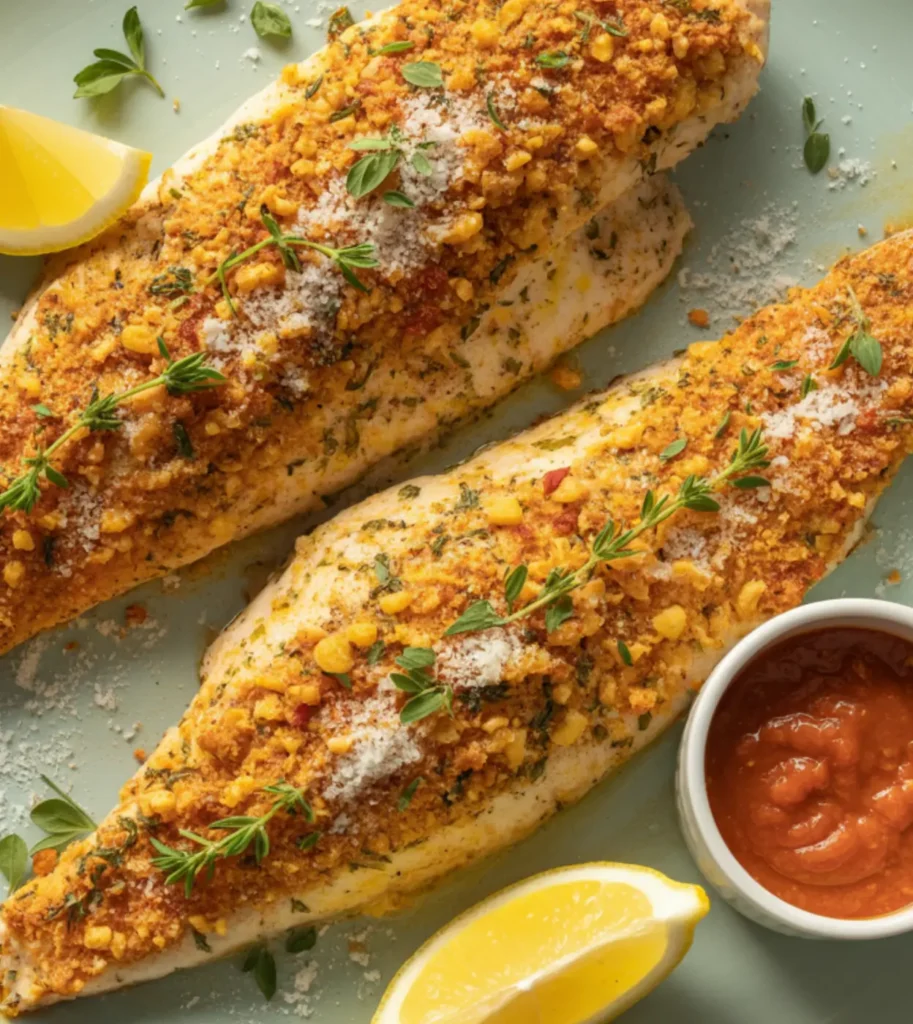
Top Tips for Perfecting Baked Catfish
After testing this recipe countless times, I’ve discovered several techniques that elevate baked catfish from good to exceptional:
Selecting and Preparing the Fish:
- Choose fresh catfish: Look for firm, moist fillets with no strong fishy odor. Farm-raised catfish tends to have a milder flavor than wild-caught, which some people prefer.
- Uniform thickness matters: Try to select fillets of similar thickness, or adjust the cooking time accordingly for different sizes. For very thick pieces, you can make a few shallow diagonal cuts on the surface to help them cook evenly.
- Don’t skip drying the fish: Thoroughly patting the fillets dry is perhaps the most crucial step for achieving a crispy coating. Excess moisture creates steam, which prevents proper browning.
- Consider a quick brine: For extra flavor and moisture, you can brine the catfish in a solution of 1 tablespoon salt dissolved in 4 cups of cold water for 15-30 minutes before cooking. Rinse and dry thoroughly afterwards.
Perfecting the Coating:
- Panko makes a difference: The Japanese-style breadcrumbs are lighter and crispier than regular breadcrumbs. If you can’t find panko, use regular breadcrumbs but add an extra tablespoon of cornmeal for texture.
- Press firmly but gently: When coating the fish, use enough pressure to make the breading adhere well, but be careful not to compress the delicate fillets.
- Let it rest before baking: For an even crispier result, let the coated fillets rest on the rack for 5 minutes before baking. This helps the coating firm up and stick more effectively.
- Spray before baking: A light mist of cooking spray over the coated fillets just before baking can help achieve golden-brown perfection.
Baking Techniques:
- Use the wire rack: Elevating the fish allows heat to circulate underneath, preventing a soggy bottom.
- Preheat thoroughly: Make sure your oven has reached the full temperature before inserting the fish.
- Don’t overcook: Catfish continues cooking for a minute or two after removal from the oven. Take it out when it just begins to flake with a fork to avoid dryness.
- Check for doneness: The fish is done when it reaches an internal temperature of 145°F (63°C) and flakes easily with a fork.
Flavor Variations:
- Cajun-style: Replace all the herbs and spices with 2-3 tablespoons of your favorite Cajun seasoning blend.
- Italian-inspired: Use Italian-seasoned breadcrumbs, increase the Parmesan to 1/4 cup, and add 1 teaspoon of Italian herb blend.
- Lemon-pepper: Double the lemon zest and add 2 teaspoons of coarsely ground black pepper.
- Southwest: Add 1 teaspoon of ground cumin and 1/2 teaspoon of ground coriander to the spice mixture.
Storing and Reheating Tips
While baked catfish is definitely at its prime when freshly made, proper storage and reheating can help preserve its quality for leftovers:
Refrigeration:
- Allow any leftover baked catfish to cool completely (but don’t leave it at room temperature for more than 2 hours).
- Keep in an airtight container in the refrigerator for up to 2 days. Use parchment paper between pieces to prevent them from sticking.
- The coating will naturally soften in the refrigerator due to moisture, but proper reheating can help restore some crispness.
Freezing (if necessary):
- While not ideal, you can freeze baked catfish if needed. Place cooled fillets on a parchment-lined baking sheet and freeze until solid (about 2 hours).
- Transfer frozen fillets to a freezer-safe container or heavy-duty freezer bag, with parchment paper between layers.
- Frozen baked catfish can be kept for up to 1 month, though the texture quality will diminish somewhat.
Reheating Methods:
For Best Results (Oven Method):
- Preheat oven to 350°F (175°C).
- Place refrigerated catfish on a wire rack over a baking sheet.
- Lightly spritz with olive oil spray to help restore moisture and crispness.
- Heat for 10-12 minutes until warmed through and somewhat crispy again.
Quick Option (Toaster Oven):
- Preheat toaster oven to 325°F (165°C).
- Place the catfish directly on the toaster oven rack or tray.
- Heat for 7-10 minutes until warmed through.
If Frozen:
- Thaw in the refrigerator overnight for best results.
- Reheat using the oven method, adding 3-5 minutes to the reheating time.
Avoid the Microwave If Possible:
Microwaving will make the coating soggy and can give the fish a rubbery texture. If you must use a microwave, place the fish on a microwave-safe plate, cover with a damp paper towel, and heat on 50% power in 30-second intervals until just warmed through.
By following these detailed instructions and tips, you’ll create baked catfish that’s so flavorful and satisfying, you might never go back to the fried version. This healthier approach delivers all the taste without the guilt, proving that “lighter” doesn’t have to mean “less delicious.” Enjoy your crispy, perfectly seasoned baked catfish!
click here to follow me on pintereat
Baked Catfish: How to Get Flavor Without Frying
Cuisine: Southern AmericanDifficulty: Easy4
servings15
minutes20
minutes350-400
kcalBaked Catfish is a flavorful and healthier Southern-style dish featuring tender fillets coated in a crispy, golden crust of seasoned panko, cornmeal, herbs, and Parmesan. Infused with zesty lemon and a subtle kick of cayenne, this oven-baked alternative delivers classic comfort with a lighter touch.
Ingredients
4 catfish fillets (about 6 ounces each), patted dry
2 tablespoons olive oil or melted butter
1 tablespoon fresh lemon juice
2/3 cup panko breadcrumbs
1/3 cup cornmeal (yellow or white)
2 tablespoons grated Parmesan cheese
1 teaspoon paprika (regular or smoked)
1 teaspoon garlic powder
1 teaspoon onion powder
1 teaspoon dried thyme
1 teaspoon dried oregano
1/2 teaspoon cayenne pepper (adjust to taste based on your heat preference)
1 teaspoon salt
1/2 teaspoon freshly ground black pepper
Zest of 1 lemon
Lemon wedges
Fresh parsley, chopped
Hot sauce (optional)
Instructions
- Preheat and Prep
Preheat your oven to 425°F (220°C). Line a baking sheet with parchment or foil and place a wire rack on top. Lightly grease the rack. Pat the catfish fillets dry with paper towels to help the coating stick and promote crispness. - Make the Breading
In a shallow dish, mix together the panko, cornmeal, Parmesan, paprika, garlic powder, onion powder, thyme, oregano, cayenne, salt, pepper, and lemon zest. Stir well to combine the seasonings evenly. - Coat the Fillets
In a small bowl, combine olive oil (or melted butter) with lemon juice. Brush both sides of each fillet with the mixture. Press the fillets into the breadcrumb blend, coating all sides evenly. Transfer coated fillets to the wire rack, spaced about an inch apart. - Bake
Place the baking sheet on the oven’s center rack and bake for 15–20 minutes, until the coating is golden and the fish flakes easily with a fork. For extra crunch, broil for the last 1–2 minutes, keeping a close eye to avoid burning. - Rest and Serve
Remove the catfish from the oven and let rest for 2–3 minutes. Plate and garnish with fresh parsley and lemon wedges. Serve hot, with hot sauce on the side if desired.
Notes
- This dish combines classic Southern catfish flavor with a healthier baking method, skipping the deep fryer without sacrificing texture or taste. The blend of panko and cornmeal gives the coating a satisfying crunch, while lemon zest and herbs keep the flavor bright and balanced. Perfect for weeknight dinners, it’s also easily customized. try adding hot sauce for extra heat or serving with a side of coleslaw and roasted vegetables for a complete meal.

